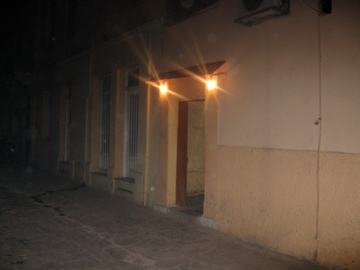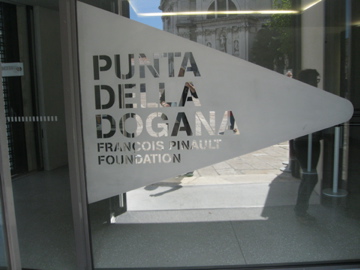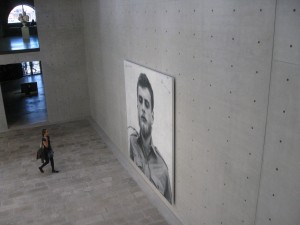
Front door in Kerameikos
Upon arriving in Athens, several curious and helpful people gave me every warning to stay far away from the Kerameikos and Metaxourgeio neighborhoods, which was exactly where I was headed, for ReMap KM 2. Settled by new immigrants from Egypt, Iran, Afghanistan, and Lebanon, and dubbed Little Bangladesh, these neighborhoods are defined by poverty, drugs, petty crime, and prostitution.
Just as I was about to head into the first gallery, Nice & Fit from Berlin, a teenager came barreling around the corner, ran out into the intersection, and was gone without a trace. Six of Athens’s finest gave chase for a couple blocks before giving up the pursuit. Perhaps the bad reputation is sadly deserved. But there was a tremendously festive spirit that night. Hundreds of brave art appreciators were following maps, strolling between abandoned buildings where the 21 international galleries and 16 independent projects had set up squats. It felt like we visitors had set up a block party on derelict pedestrian streets after the residents had agreed to disappear for the night.
Many of us ended our tours at Breeder Gallery’s elegant new space at the end of the nearly empty Iasonos Street. Co-owner George Vamvakidis explained to me that these seedy blocks were once part of Athens’s most affluent neighborhood, the grand homes creating a romantic passageway. As the city expanded, younger residents moved to further out suburbs, their parents died, and the crumbling facades were left to decay. I asked George if it had been a good idea to relocate his gallery to oblivion. He said he liked the action the street gets—all types of action—and that the foot traffic increased as the city grew darker each night. As it turns out, the vast majority of the seemingly abandoned-looking buildings were far from empty. Rather, they had been adapted into brothels, woven into the massive web of Greece’s legal sex trade.
Early the next morning, when I returned to the area to take a few photos in the light, I found myself walking behind the only other person who was out and about. He was dressed smartly, with a polo shirt tucked into his jeans and I assumed him to be a fellow tourist, perhaps a gallery-hopping collector, as we were both fumbling maps while walking. Suddenly he stopped, looked left, looked right, steadied himself, and then bolted through the front door of one of the brothels. I was left alone in the middle of the walkway completely surprised.
Perhaps it isn’t so shocking, the intertwining of ad-hoc galleries amongst prostitutes. Certainly, artists have long investigated the links between the two ancient professions. Marlene Dumas famously wrote, “lf a Prostitute is a person / who makes it a profession/ to gratify the lust of various persons / for economical reasons or gain, / where emotional involvement may / or may not be present— / Then it seems not so far removed / from my definition of an artist.” And six years ago, Andrea Fraser debuted her video, Untitled. She had sex with an unnamed collector who had paid her $20,000, then displayed the bird’s-eye-view footage in galleries around the world. (The $20,000 apparently did not cover the full girlfriend experience. They commenced with intercourse, engaged in a bit of talk, and then exited to opposite sides of the frame.)
With great pleasure, artistic provocateurs have explored every angle of the sex trade, but my recent European vacation made me wonder about the exploitative nature of the art viewer. See, in full confession, not long after I saw the john in Athens, I engaged in my own degrading activity — only mine took place at the entrance gate of an art museum in Venice.
Later that week, swept up in the frenzy of seeing as many exhibitions and venues as humanly possible during the Venice Biennale, I found myself in a disturbing internal debate about spending 15 euros ($22 dollars) for the privilege of entering François Pinault’s new Punta della Dogana at the very tip of Dorsoduro. I understood how that gentleman back in Metaxourgeio had felt, steadying himself before entering the whorehouse. I started in, then turned around. I glanced at the people sunning themselves on the steps of the Basilica di Santa Maria della Salute, then ducked my chin to hide my face. Really, did they know what I was up to? It’s hard to explain my moral indignation, how little I wanted to play a part in subsidizing the play palace of the billionaire owner of Gucci, Christie’s Auction House, and Yves Saint Laurent. Architect Tadao Ando did masterful, elegant work calculating the balance between existing raw structures and the polish of new concrete. The work was what you would expect — big trophy pieces created by big trophy names. Despite the splendor of the work, it felt like a contemporary auction catalogue; thrown together in real life, it lacked any sense of curatorial soul. Amidst the grandiosity there were highlights: grand Sigmar Polke paintings that I couldn’t imagine seeing anywhere else, Mike Kelley’s Kandors that looked better here in a pitch-black room then they did at the Carnegie International, and Maurizio Cattelan’s marble sculptures seemed cramped but striking. In an amusing twist, another art/sex mixing was on view, on the form of Jeff Koons’s kitschy marble Bourgeois Bust-Jeff and Ilona (1991), the faux-classical portrait of the artist embracing his ex-porn star wife.

Punta Della Dogana
At the giftshop, I discovered that for 54 euros ($75), I could be the proud owner of a canvas Punta Dogana tote bag designed by Stella McCartney. Of course, it was required I check all bags, so that cost another 3 euros. The whole operation felt like a scam, an elaborate, strict amusement park with beautiful art—and hands stuck out from every corner. While leaving the Dogana I saw a long line of people behind stanchions waiting to pay admission, queueing up for the privilege of having the building’s price tag passed on to them.

Inside the Dogana Galleries
I’ve always believed in the museum free market: quality exhibitions programming, scholarship, and educational endeavors can and should be rewarded. And certainly, the work in Pinault’s collection is something we want to see and should be able to see (an average of 3,000 people a day did during the 2007 Biennale). However, it’s become a vicious cycle. We complain about the rising costs of sporting events, movies, and concerts, yet we assume our cultural leaders will keep the arts fiscally viable and open for the masses. When museum admissions climb past $20, the proverbial family of four faces the indignity of inaccessibility (it is also ill-advised to take the family gallery hopping among brothels). This is when we need the billionaires’ club to reconsider its philanthropic aspirations, instead of price-gouging. The rich play on the civic duty of bringing a collection (in this case, over 2,500 works) to the public, but only get richer by making us pay to play. In fairness, there are price breaks, such as: ‘Every Wednesday, Free Entrance for Venetians’ and the oddly phrased, ‘free admission for the Seriously Disabled’ — who determines this?
I am still filled with shame that I participated in Pinault’s gluttonous money grab. To get even, I will not be purchasing any Gucci in the near future.




Pingback: Summer Travelogue « Fire EXIT
Pingback: New Guest Blogger: Quinn Latimer | Art21 Blog